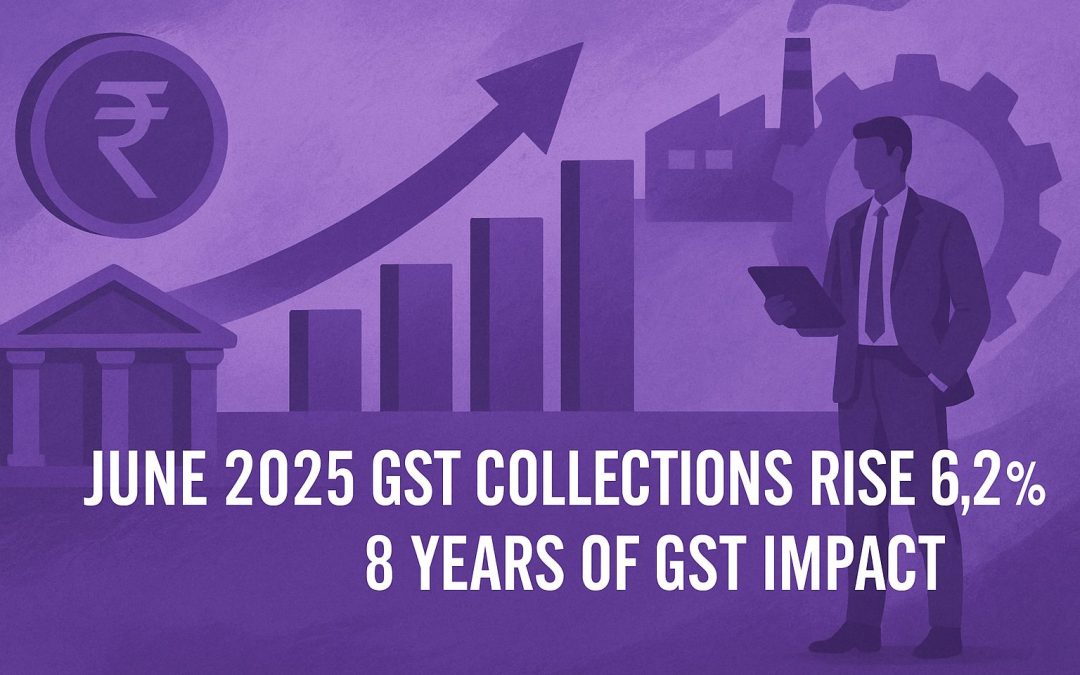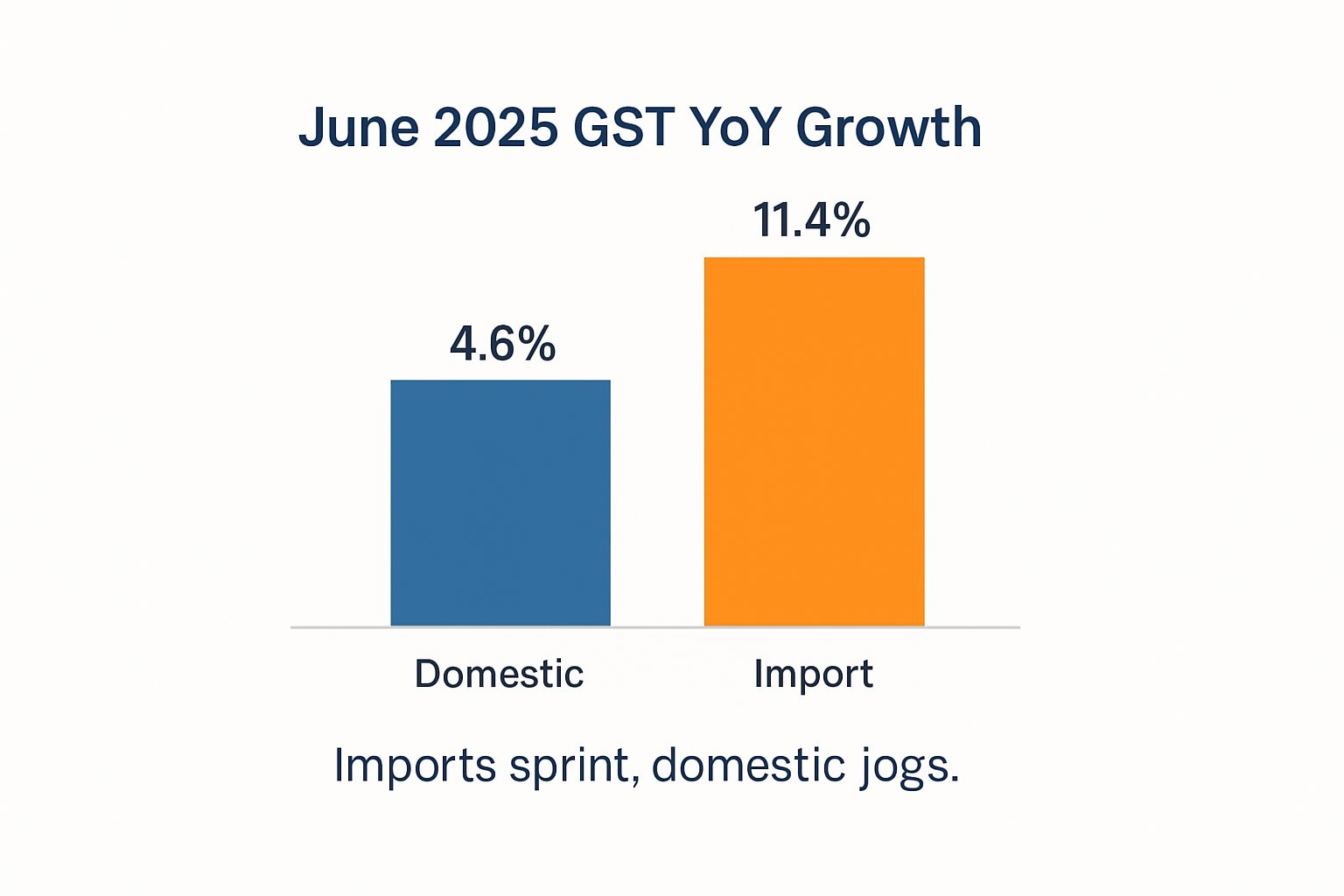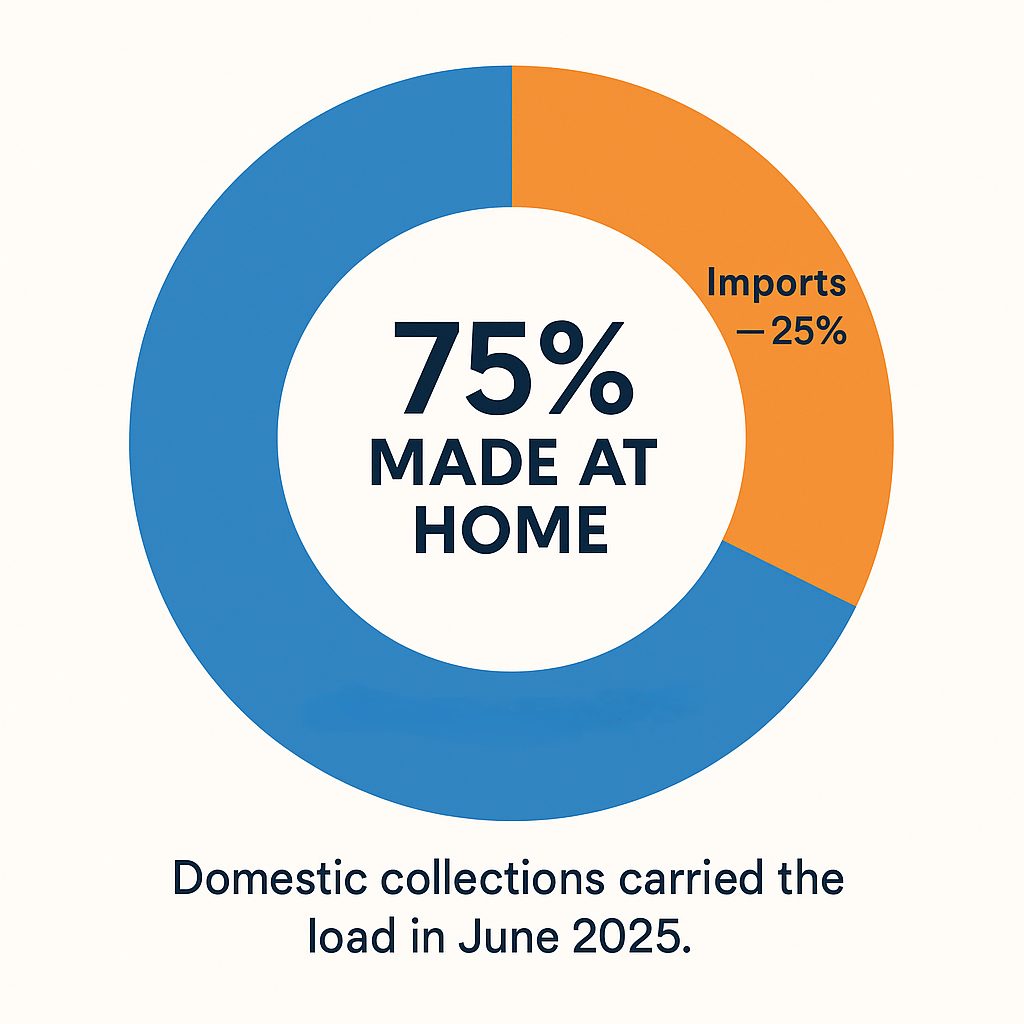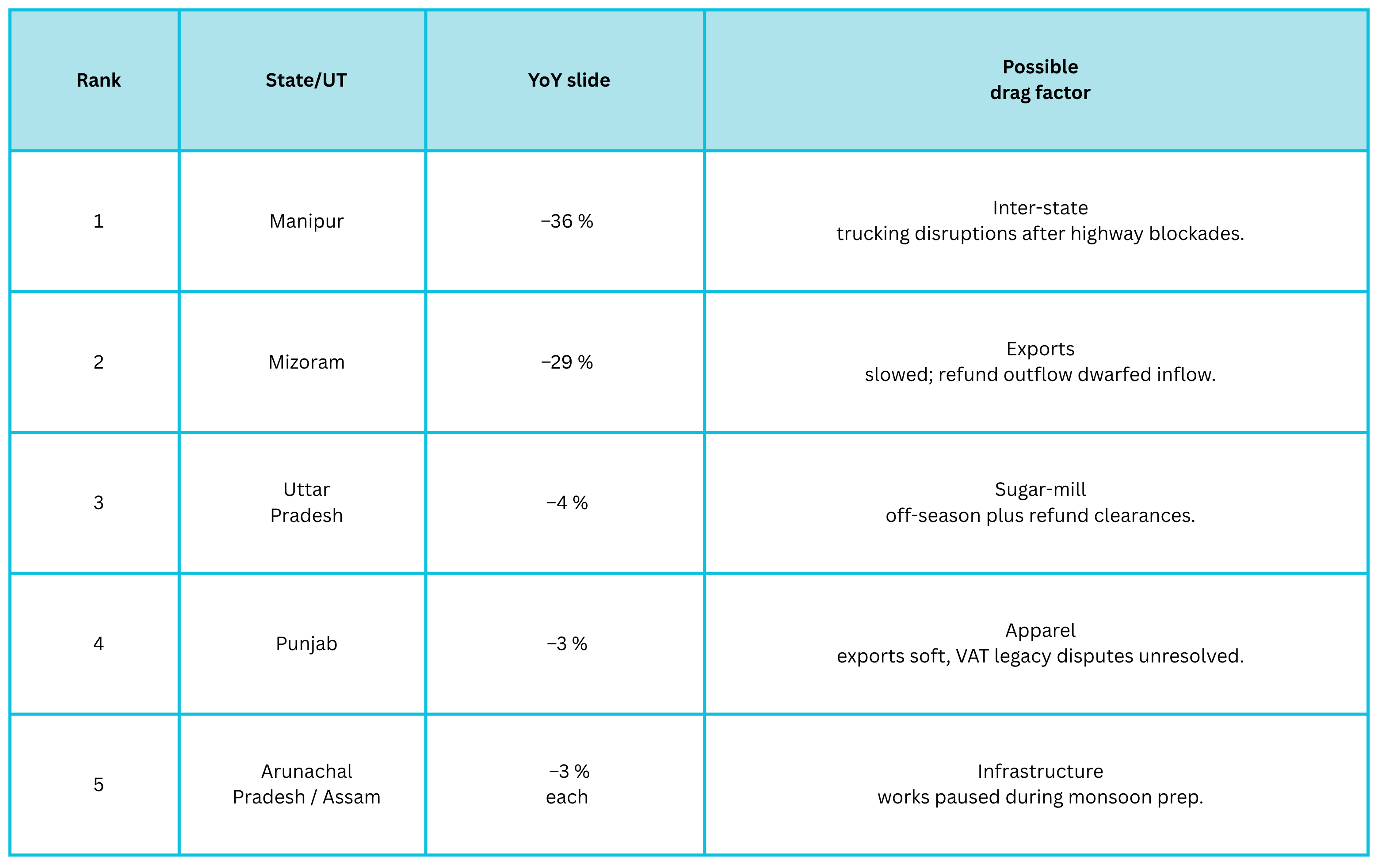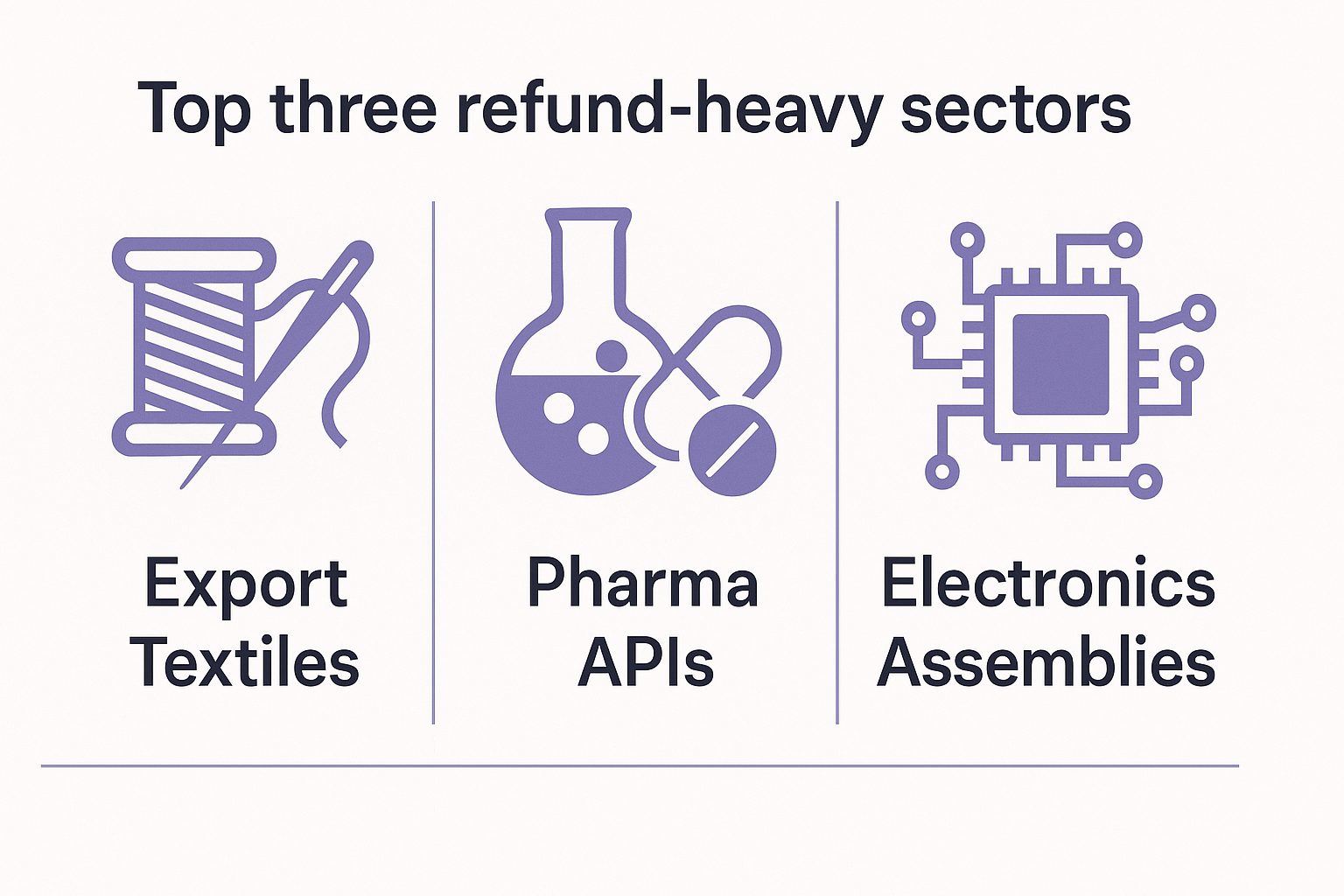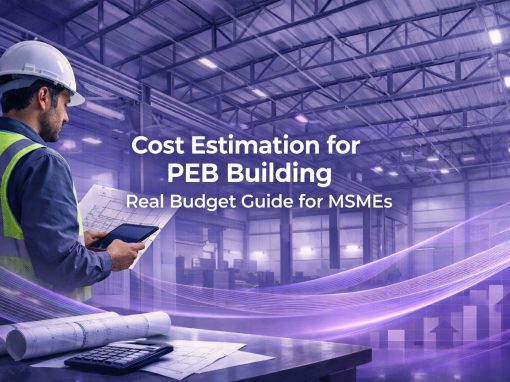Table of Contents
- Introduction
- What Powered June’s Bump?
- State Scoreboard — Who’s racing ahead, who’s stuck in second gear
- Refund Pipeline — Still a Kicker
- Checklist: surf the undertow, don’t drown in it
- Eight Years of GST — Three Big Wins
- Three Potholes We Still Hit After Eight Years
- Q2 Playbook: Keep the GST Cash-Flow Tap Wide Open
- GST Compliance Calendar | July – September 2025
- Closing Take
₹1.84 lakh crore—that’s the June 2025 GST Collection, 6.2 % stronger than last year’s tally. After carving out refunds, the pot actually available to Centre and States sinks to ₹1.59 lakh crore, a slimmer 3.3 % rise.
Where did the momentum come from?
- Domestic trade: ₹1.39 lakh crore, nudging ahead by 4.6 %
- Imports: ₹45,690 crore, vaulting 11.4 % as global freight normalised
- Refund drag: Outflows of ₹25,491 crore surged 28.4 %, pruning the net kitty
June’s bump leans heavily on import IGST, while the home market is growing—but at a measured jog, not a sprint. Factor in faster refund clearances when modelling cash flow; otherwise, your July GSTR-3B payment may feel tighter than headline numbers suggest.
What Powered June’s Bump?
June’s ₹1.85-lakh-crore headline looks stout, but peek under the hood and two pistons do most of the firing:
| Engine | June ’25 Gross (₹ cr) | YoY growth |
| Domestic trade | 1,38,906 | 4.6 % |
| Imports | 45,690 | 11.4 % |
Imports are back in fighting form. Cheaper freight and a late-summer restock pushed IGST on imports up by nearly one-eighth. Domestic demand, by contrast, is recovering in deliberate steps—enough to keep the wheels turning, not enough to rattle the showroom glass.
“Three-quarters of every GST rupee still comes from inside the country; the last quarter sailed in through port gates.”
—A finance ministry official, off-record.
The refund undertow
Refunds, that perennial spoiler, ballooned to ₹25,491 crore—up 28.4 % YoY . Faster processing is great for exporters but shaves the net kitty. Net domestic revenue, after refunds, inched up by a modest 3.7 %.
Why it matters for businesses
- Working-capital crunch: Quicker refunds mean quicker cash-outs; tighten your July-August cash-flow map.
- Import-heavy sectors: Electronics, precision machinery, and pharma stand to feel the freight-cost relief first—time to recalibrate pricing.
- Domestic-only players: A 4-5 % sales lift won’t cover sloppy receivables. Double-down on credit-control before the monsoon spending dip.
State Scoreboard — Who’s racing ahead, who’s stuck in second gear
The five sprinters
Quick pulse: High-growth states share one trait—fresh compliance onboarding, not just higher sales. Keep an eye on e-invoice thresholds being lowered elsewhere; the growth baton may pass quickly.
The five stragglers
Take-aways for finance teams
- Operate in a laggard state? Budget for slower credit utilisation; authorities tend to audit harder when revenues dip.
- Sell into a sprinter? Push invoices early this quarter—state tax admins are usually more generous with ITC matching while on a growth high.
- Pan-India businesses: Expect sharper cross-state reconciliations; divergent growth rates amplify mismatch notices.
Refund Pipeline — Still a Kicker
The hard maths
- ₹25,491 crore went back to taxpayers in June 2025—28.4 % higher than last year’s June cheque.
- After refunds, net collections cooled to ₹1.59 lakh crore, trimming the headline gain from 6.2 % to 3.3 %.
- Export-led sectors claimed over ₹11,800 crore in IGST refunds, thanks to sped-up customs validations.
Snapshot: Every rupee of faster refund frees up working capital for industry—good for growth, but it clips the Centre-State pie in the short run.
Why the surge?
- Customs EDI 3.0 rollout cut average verification time to 7 days.
- Inverted duty claims from textiles and pharma finally cleared after policy tweaks in April.
- Export comeback: Electronics and speciality chemicals pushed outbound invoices 14 % higher YoY.
Checklist: surf the undertow, don’t drown in it
| Action | Why it matters | Quick win |
| Model refund lags | Cash can vanish for 15–20 days before reimbursement | Tie refund ETA to treasury forecasts |
| Segment refunds by type | IGST vs inverted-duty claims have different clocks | Use separate tracking columns in ERP |
| Review LUT/Bond validity | Lapsed letters delay zero-rated exports | Calendar a 30-day pre-expiry alert |
| Automate matching (GSTR-2B vs shipping bills) | Mismatch notices balloon litigation risk | Deploy rule-based reconciliations weekly |
Bottom line: Fast refunds are a boon—until they coincide with advance-tax season. Pad liquidity now; the July 20 GSTR-3B deadline won’t wait for your refund to hit.
Eight Years of GST — Three Big Wins
“Eight monsoons on, the GST juggernaut has shed its training wheels and is roaring down the highway.”
Revenue buoyancy that now rubs shoulders with direct taxes
- Q1 FY 2025-26 (Apr-Jun ’25) grossed ₹6.22 lakh crore, a hefty 11.8 % YoY rise—the best first-quarter haul on record.
- Even after refund knocks, net inflows for the quarter touched ₹5.42 lakh crore, up 10.7 %.
- Compare that to Year 1’s sub-₹1 lakh-crore monthly average and you’re staring at an almost two-fold leap.
- Why it matters: The Centre’s direct-tax kitty used to dwarf indirect taxes; the gap is now a slim speed-breaker. Budget planners can finally bank on GST as a dependable cash cow rather than a moody calf.
Hard-nosed take: If collections keep compounding at 10 %-plus, GST alone could fund one out of every three Union-budget rupees by 2030.
A compliance base that’s bigger, smarter, and (mostly) paper-free
89.34 lakh returns were filed by state formations in just the first quarter of FY 2025-26 ; add central data and the active GSTIN universe now sits north of one crore.
- What greased the wheels?
- E-way bill in 2018 that crushed ‘bill-to-ship-to’ arbitrage.
- E-invoice in 2020 that made fake credits feel like VHS in a Netflix world.
- AI-driven anomaly engines in 2023-24 throw mismatch alerts before you can say “Section 16(4)”.
- Why it matters: With every new GSTIN comes a fresh breadcrumb trail—great for forensic audits, scary for fly-by-night founders. And yes, it finally levels the playing field for honest MSMEs.
Refunds that hit bank accounts before the coffee gets cold
- June 2025 saw ₹25,491 crore fly back to taxpayers, a 4 % YoY jump .
- Export IGST refunds alone cleared ₹12,688 crore, thanks to Customs EDI 3.0 and rule-based matching .
- Average refund turnaround: down from calendar-killing fortnights to single-digit days (textile exporters report 7-day credits).
- Why it matters: Working capital is oxygen. Faster refunds mean exporters can chase new POs without taking a detour to the overdraft counter.
| CFO Move | Immediate Upside | Long-term Edge |
| Plug refund ETAs into treasury forecasts | Avoid mid-month cash crunch | Lower borrowing costs |
| Segment refund types in ERP | Detect stuck IGST claims early | Slash litigation exposure |
| Sync LUT/Bond expiry alerts | Keep zero-rated exports smooth | Preserve GST rating score |
The road ahead
GST isn’t the “grand experiment” anymore—it’s India’s default fiscal arteria. The next frontier? Real-time input credit via B2B invoice QRs and predictive compliance nudges. Strap in; year nine promises to be the most data-driven lap yet.
Three Potholes We Still Hit After Eight Years
Rate Roulette
A single HSN typo can flip a five-percent tax into an eighteen-percent nightmare. Since July 2017, the Council has tweaked slabs and exemptions more than 400 times. Each change forces finance teams to play whack-a-mole with SKUs, ERPs, and supplier master sheets. Nail every item to an eight-digit code, give one “rate custodian” veto power over price lists, and log revisions like version control in software. That unglamorous spreadsheet may one day save you 18 % interest and a month of notice replies.
Cash on Ice
Refunds are quicker, but cash still waits a week in limbo. June 2025 pushed ₹25,491 crore back to taxpayers—great optics, yet ₹18,000-plus crore was IGST first paid, then reclaimed . Rule 86B caps credit use for high-turnover firms; inverted-duty sectors (textiles, pharma, EV parts) park crores they may never fully recover. Block out Friday afternoons for a three-way match—2B vs books vs supplier filings. Flag anything unmatched, and park “frozen credit” in its own ledger column so your cash-flow model doesn’t lie.
Courtroom Queue
Data-mining bots at DGGI flag a 5 % GSTR-1/3B gap within days, while legacy VAT and CST disputes still clog the tribunals. Keep e-invoices in an immutable vault, lock variance at 5 % or below, and budget a 1 % turnover legal reserve—cheaper than an emergency loan when a showcause lands.
| Quick Fix | Pay-off |
| Version-control rate sheet | Stops slab whiplash |
| Friday 3-way match | Cuts credit-freeze surprises |
| 1 % litigation kitty | Keeps CFO pulse steady |
Bottom line: GST’s Road is smoother than in 2017, but these three bumps still rattle the suspension. Patch them, and the next eight years will feel less like an obstacle course and more like cruise control.
Q2 Playbook: Keep the GST Cash-Flow Tap Wide Open
(July – September 2025)
Treat refunds like weather forecasts — build them into the week.
Pull your last half-year of IGST and inverted-duty claims, jot the actual days-to-credit on a sticky note, and plug that average into the July-September cash forecast. When the 20 July GSTR-3B bill hits, you’ll already have an umbrella open.
Make Friday “match-up” hour sacred.
Spend the last hour of every Friday lining up three columns: the fresh GSTR-2B, your purchase ledger, and the supplier upload status. Anything that doesn’t line up goes straight onto Monday’s chase list, not into the taxman’s anomaly inbox.
Give every SKU an eight-digit passport.
One product, one HSN, end of story. Appoint a ‘rate warden’ who can veto price-list changes until the code is confirmed. When the next Council tweak lands (likely late August), you’ll swap rates in minutes, not days.
Exporters: check the expiry on your LUT before the kettle boils.
A Letter of Undertaking that lapses on you turns a zero-rated shipment into an instant tax outflow. Set a 30-day email ping for every LUT or bond in the drawer.
Park a rainy-day legal jar — 1 % of the quarter’s turnover.
Not glamorous, but when a DRC notice ambushes your inbox, it’s cheaper to dip into a ready pot than beg the bank for an overdraft.
Tiny tweaks, big breathers
- Sync GST deadlines to the team’s phone calendars; buzz them two days early.
- Colour-code ITC in your ERP: green (free to use), amber (blocked), red (in dispute). One glance, honest cash picture.
- Throw a simple bar chart on the office TV showing refund amounts against days outstanding — managers chase what they can see.
Bottom line: Q2 is short on slack. Nail these five habits now and your GST obligations will drip, not gush, out of the bank account.
GST Compliance Calendar | July – September 2025
| Month | Date | Return / Payment | Who’s on the hook |
| JUL | 11 Jul 25 | GSTR-1 (Jun, monthly filers) | Turnover > ₹5 cr |
| 13 Jul 25 | IFF / GSTR-1 (Apr–Jun, QRMP) | Turnover ≤ ₹5 cr | |
| 18 Jul 25 | CMP-08 (Q1) | Composition dealers | |
| 20 Jul 25 | GSTR-3B (Jun, monthly) | All regular taxpayers | |
| 22 / 24 Jul 25 | GSTR-3B (Q1, QRMP) | Group A / Group B states | |
| AUG | 11 Aug 25 | GSTR-1 (Jul) | Monthly filers |
| 20 Aug 25 | GSTR-3B (Jul) | Monthly filers | |
| SEP | 10 Sep 25 | GSTR-7 / 8 (TDS / TCS for Aug) | E-commerce & deductors |
| 11 Sep 25 | GSTR-1 (Aug) | Monthly filers | |
| 13 Sep 25 | GSTR-5 / 6 (Aug) | NRTP / ISD | |
| 20 Sep 25 | GSTR-3B (Aug) | Monthly filers | |
| 25 Sep 25 | PMT-06 (Aug, QRMP) | Quarterly payers |
Three survival tips that beat reminder apps
- Block a calendar hold at 3 p.m. two days before each filing. Treat it like a flight; you wouldn’t board late.
- Colour-code returns in your ERP dashboard—red due, amber tomorrow, green done. People chase colours faster than emails.
- Run a five-minute variance check (GSTR-1 vs 3B) right after filing. Catch a mismatch now, dodge a notice later.
Closing Take
Every July the same question lands on the finance desk: Will the monsoon dampen receipts, or will the festive quarter shout them higher? This year the answer could be “both, but in sequence.”
- July–August: If rainfall tracks the IMD’s “normal” call, rural wallets loosen just enough to keep FMCG wheels spinning, yet not enough to offset the usual pre-season lull. Expect collections to tread water—think ₹1.80–₹1.83 lakh crore, much like June’s ₹1.84 lakh crore take.
- September and beyond: The Diwali build-up is long this year (mid-October fireworks, early November New Year bookings). Add a likely oil-price breather and freight rates that finally look sane, and imports should sprint again. A month touching ₹1.90 lakh crore isn’t moon-shot territory.
What could spoil the party? Two problems hover:
- Rate-tweak fatigue. Another round of slab shuffles could freeze purchasing decisions for a fortnight—long enough to shave a few thousand crores off a month’s tally.
- Credit-lock hangover. If Rule 86B stays put and inverted-duty refunds lag, MSME cash could seize up right when festive orders peak.
Bottom line: June gave us momentum; the clouds will test it. Keep refund ETAs honest, guard those HSN codes, and stash that 1 % legal buffer. Do that, and the coming quarter should feel like a steady drizzle of revenue—before the festival megaphone cranks the volume.
FAQs
What is the average monthly GST collection target for FY 2025-26?
How does GST impact India’s fiscal deficit?
Which goods saw the highest GST slab changes recently?
What is the penalty for late GSTR-3B filing in 2025?
How does GST affect MSMEs in rural areas?
Are e-invoices mandatory for all businesses in 2025?
What is Rule 86B and who does it apply to?
Can GST refunds be tracked online?
How does monsoon season impact GST collections?
What sectors are eligible for zero-rated GST benefits?
A product manager with a writer's heart, Anirban leverages his 6 years of experience to empower MSMEs in the business and technology sectors. His time at Tata nexarc honed his skills in crafting informative content tailored to MSME needs. Whether wielding words for business or developing innovative products for both Tata Nexarc and MSMEs, his passion for clear communication and a deep understanding of their challenges shine through.
